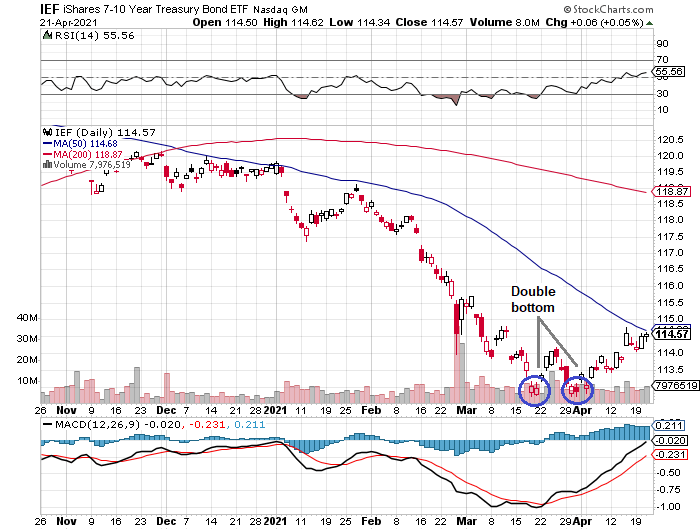The 10-year Treasury yield ticked down for a second day, settling at 1.57% (Apr. 21). That’s close to the lowest rate in over a month. If the 10-year rate closes lower on Friday vs. the week-ago yield, the slide will mark the third straight weekly decline.
The downside bias in Treasury rates is keeping iShares 7-10 Year Treasury Bond (NYSE:IEF) ticking higher (bond prices move inversely with interest rates). After declining for much of the previous nine months, IEF is rising again. For how long? Unclear. There was a brief rally in January, but that faded quickly. Is this time different?
One difference vs. the January bounce: IEF twice tested a support level at around $113 and has rallied from there. From a technical perspective, that’s encouraging. Deciding if it’s something more that a short-term trade is a work in progress.
The next technical test of note: the 50-day average, namely: Can IEF muster a convincing rally above the 50-day average? Or does that end up as the ceiling?
How the market is perceiving inflation risk will play a big role in the outcome and on that score there’s a fierce debate. Inflationistas are warning (still) that trouble’s brewing and the blowback has only just started.
“All the signs are for inflation starting to break out,” Former Treasury Secretary Larry Summers said yesterday. He added that various inflation indicators were “flashing red,” pointing to the $1.9 trillion COVID-19 relief bill that became law in March.
“We were providing demand well in excess over the next couple of years of any plausible estimate of the economy’s potential to produce, and that meant substantial price increases,” he said at a Council on Foreign Relations forum on Wednesday.
If Summers is correct, the bond market’s headed for trouble. But several prominent voices counter that disinflation/deflation is still running the show. Jeff Snider at Alhambra Partners, in a detailed interview last week, makes a compelling case that the D/D trend that’s prevailed for several decades may be on hiatus but it has yet to fully play out.
Hoisington Investment Management has a similar view, recently advising:
"Contrary to the conventional wisdom, disinflation is more likely than accelerating inflation. Since prices deflated in the second quarter of 2020, the annual inflation rate will move transitorily higher.
"Once these base effects are exhausted, cyclical, structural, and monetary considerations suggest that the inflation rate will moderate lower by year end and will undershoot the Fed Reserve’s target of 2%. The inflationary psychosis that has gripped the bond market will fade away in the face of such persistent disinflation."
How will the bond market process these conflicting outlooks? Incoming economic data will eventually provide the necessary clarity, one way or the other. But that’s going to take time.
Meantime, there are compelling arguments on both sides of the aisle. On that basis, any upside run for IEF is probably limited until we get on the other side of the “base effects,” probably at some point in the 2021’s second half.
That leaves the crowd with the task of deciphering the relevance of the recent bounce in bond prices. Here’s the outlook that looks compelling to this analyst at the moment: IEF is stuck in a trading range for the near term.
Unless there’s a run of sharply surprising economic data, churning looks like a reasonable forecast for IEF and comparable funds and strategies in the fixed-income space until the data suggests otherwise.


